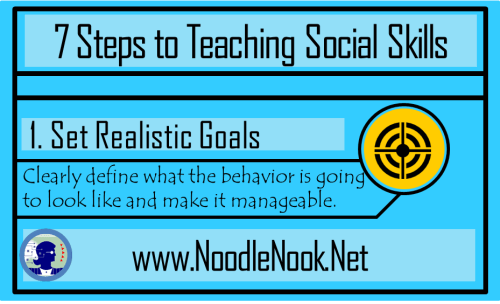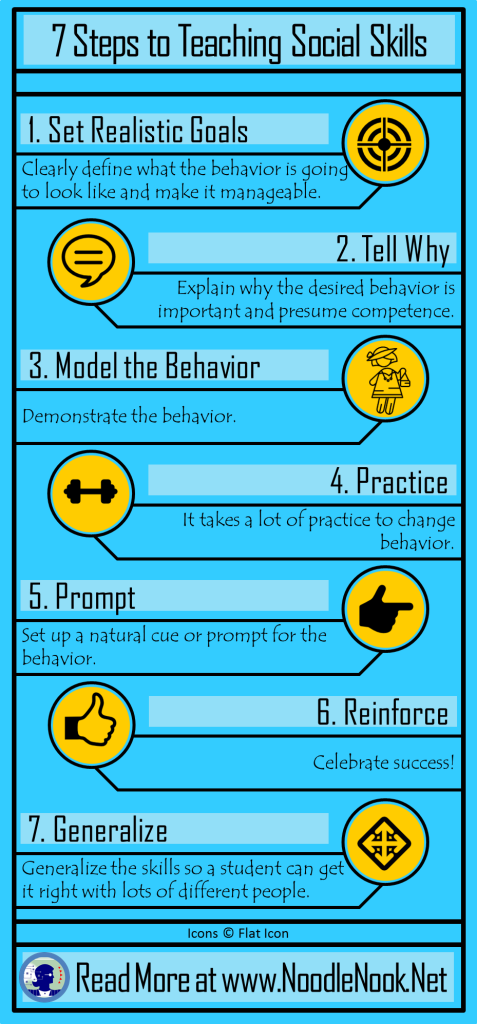Addressing social skills when working with students with Autism is hard. Consistently using these seven steps to teach social skills will help.
 1. Set a realistic goal
1. Set a realistic goal
> Clearly define what the behavior is going to look like and make it manageable. Rome was not built in a day and good social skills were not crafted in a day either. Pick age appropriate behaviors that can be developed in small, manageable steps that you can chart to monitor progress. This is a critical step to teaching social skills.
2. Tell Why
> Explain why the desired behavior is important- remember to presume competence. They can hear you, understand you, and want to know why. Some people never bother to tell a student why a behavior is the right way and talk about how it makes people feel. How can you skip this important step to teaching social skills?
3. Model the Behavior
> Demonstrate the behavior- and do it without a lot of extra talking (unless you are modeling the internal dialog as part of the desired behavior). You can do this with role play, video modeling, or watching others and pointing out the appropriate targeted behavior.
4. Practice
> It takes a lot of practice to change behavior. Don’t think you will change behavior in one try… it is going to take some serious practice.
5. Prompt
> Set up a natural cue or prompt for the behavior. You have to teach what the social cue is for the desired behavior as well as the behavior. Think, does the student know when to do the behavior you are training? How can you skip this important step to teaching social skills?
6. Reinforce
> Celebrate success! When a student gets it right, remember to reinforce it. And this does not always mean food or drinks… try verbal praise, high-fives, or other non-edible reinforcers.
7. Generalize
Getting it right with you is one thing, but what happens when you are not there- does the good behavior still happen? Make sure you take that extra step and generalize the skills so that a student can get it right with lots of different people.
And there you have it! Seven steps to teaching social skills to students with disabilities.
Love this infographic? Be sure to pin it on Pinterest (and follow us too)!
Don’t Forget: Involve Peers
This is not one of the steps, but needs to be mentioned. You have to have peer involvement to really be successful with social skill training. Teaching social skills in isolation is not realistic. Several years ago, I worked on a campus that had a female student who like to smell boys and one boy in particular. The reaction on campus was to isolate the student and have her with an aide at all times. Also, she and the one boy she targeted specifically had to be separated at all times. It became so alarmist whenever the girl was in larger groups- everyone got worked up when she would look at boys and start to lean towards them… it really escalated the behavior and started to set off many other students in the group. It basically stressed everyone out.
So, you know me, I had to set the girl free by removing the para. I actually went one step further and asked to put the girl and her one targeted boy in the same class together. And the looks I got. The campus told me they were retraining the behavior with a BIP, but weren’t seeing success. Problem was, they were practicing without any peers.
Long story short- we had to teach the replacement behavior with real peers. We were not using natural prompts to trigger the appropriate behavior in this young lady and by removing her from her peers, we were actually doing her a disservice.
Research shows that a lack of peer involvement can result in social behaviors that never become functional skills (Frea, 2015).
Get Results
Using these steps consistently will help you to teach social skills to students in LIFE Skills, on the spectrum, or even young students who need to improve their social skill. Remember, you will need time to plan time to teach social skills directly. Make it a part of your daily plan just like you would for any other learning objective. Read the article by Frea below to see more on teaching skills under tight structure versus loose structure and how it impacts skill acquisition if you still want more information on crafting a plan to teach social skills. Finally, remember that visual supports are a big part of teaching LIFE Skills students or students with Autism. Include them in this process as needed to make students successful. Now, relax and teach on!

Do you like what you’re reading? Subscribe to the RSS or to get new posts by email so you are always up to date on tips, tricks, and freebies for LIFE Skills.
READ MORE: Autism Classroom Setup Essentials, Autism Classroom Setup Checklist and Implementing Rules in Autism Classrooms


I love this idea!
I found this on Pinterest with a graphic that is cutting and pasting goals and self monitoring checklist. Is that available somewhere on your website, or is it a mistaken graphic? Thanks!
Do you have the pin? If I can see it, I’ll be able to locate it for you. Thanks!
I would like to receive the token economy freebie.. and any other behavior reinforcement ideas.
Hi
You say to read the article by Frea below to see more on teaching skills under tight structure versus loose structure and how it impacts skill acquisition if you still want more information on crafting a plan to teach social skills. I cannot find this on your page, is it still available please?
Hey Tanya!
I’m not sure where that backlink went. I had some work done on my blog and I think a few functionalities did not migrate over, including the one I used to link resources, webpages and articles . I quickly snagged a list of Frea published articles that I hope will help you out. You can see those here:
https://www.researchgate.net/scientific-contributions/10287520-William-D-Frea
Good Luck!
Comments are closed.